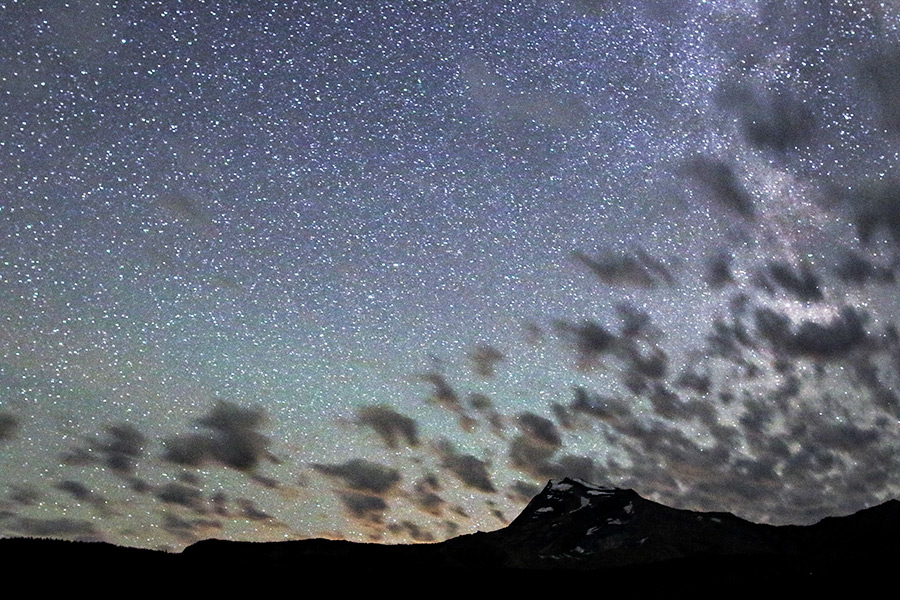
Glacier Park’s Dark Skies Illuminated Online
New webcam at Dusty Star Observatory provides visitors rare glimpse of the first international transboundary night sky preserve in the world
Experts say that 80% of the United States’ population resides somewhere it can’t view a truly dark-as-night sky. Due to urban light pollution that shrouds the globe, just one-third of humanity can look up at the night sky and clearly see the Milky Way.
Fortunately for enthusiasts of pitch-black expanses that glitter with starlight, Glacier National Park isn’t one of those places.
More than a decade ago, park managers realized that Glacier’s dark sky was a unique and important resource — one that may not have been initially considered when the park was created in 1910. To preserve the opportunity to view the Milky Way and other wonders of the galaxy, Glacier National Park and its Canadian neighbor, Waterton Lakes National Park, spent years expanding education opportunities and installing dark sky-friendly lighting. The efforts paid off in 2017, when Waterton-Glacier was named the first international dark sky park on Earth.
Mark Biel, Glacier’s natural resource program manager, helped spearhead the effort to get the international peace park designated as a dark sky preserve, and described the process as rigorous.
“This was not a simple one-page application,” Biel said of the decade-long effort. “There was a lot of work that needed to be done.”
Researchers had to take sky quality measurements in some of the park’s darkest areas. According to Biel, most places within the park have a Unihedron Sky Quality Meter (SQM) rating of 21.5 to 21.8, just a few points below a perfect 22 for a moonless night with zero artificial light. For comparison, the SQM rating of an overly lit urban area would be in the mid-teens, Biel said. Getting those sky quality measurements can be challenging. Spring and fall tend to be the best times because the nights are longer than in summer. The measurements can’t be taken in winter because any snow on the landscape would reflect into the sky and disrupt the readings.
In order to protect the darkness and maintain the designation, at least 67 percent of the lights within the park have to be night-sky friendly. That means the light is aimed at the ground and doesn’t illuminate the sky above. Glacier is currently on its way to achieving that goal.
The final component of the dark sky designation is maintaining a robust education program, which was gaining momentum before the pandemic disrupted in-person viewings and interpretive events. During the busy pre-COVID summer months, Glacier was hosting sky viewings that attract 30,000 people annually, with park staff hosting star parties at Logan Pass or placing telescopes at the St. Mary Visitor Center.
Those in-person viewings were waylaid by public health concerns, but that hasn’t stopped stargazers from being able to appreciate Glacier’s night sky, both from within the park’s boundaries and from well beyond.
Much of that expanded star-gazing capacity is due to the opening of the Dusty Star Observatory at the St. Mary Visitor Center in 2019, a project made possible by the Glacier National Park Conservancy, the nonprofit fundraising arm of the park, which contributed more than $200,000 for the International Dark Sky project, including funding for the observatory and its 20-inch Corrected Dall Kirkham telescope, which lists for around $35,000.
This year, Glacier National Park and its nonprofit partner installed a night-sky webcam at Dusty Star Observatory, transporting far-flung visitors under the park’s star-studded skyscape on a nightly basis. For digital visitors who can’t stay awake that late, each morning Glacier Park posts a time-lapse video of the previous night’s sky camera, which records the moon, the stars, and the Milky Way rising overhead, as well as clouds streaking past, lightning flashing inside thunder clouds, and an occasional appearance by the International Space Station.
Photographer John Ashley has spent three decades photographing the park and said that while people come to Glacier to see the stunning landscape in daylight, they should also take the opportunity to look up after the sun has gone down.
“Glacier is amazing during the day but it’s even more amazing at night,” he said.
Find the time lapse at the Glacier National Park webcam site.